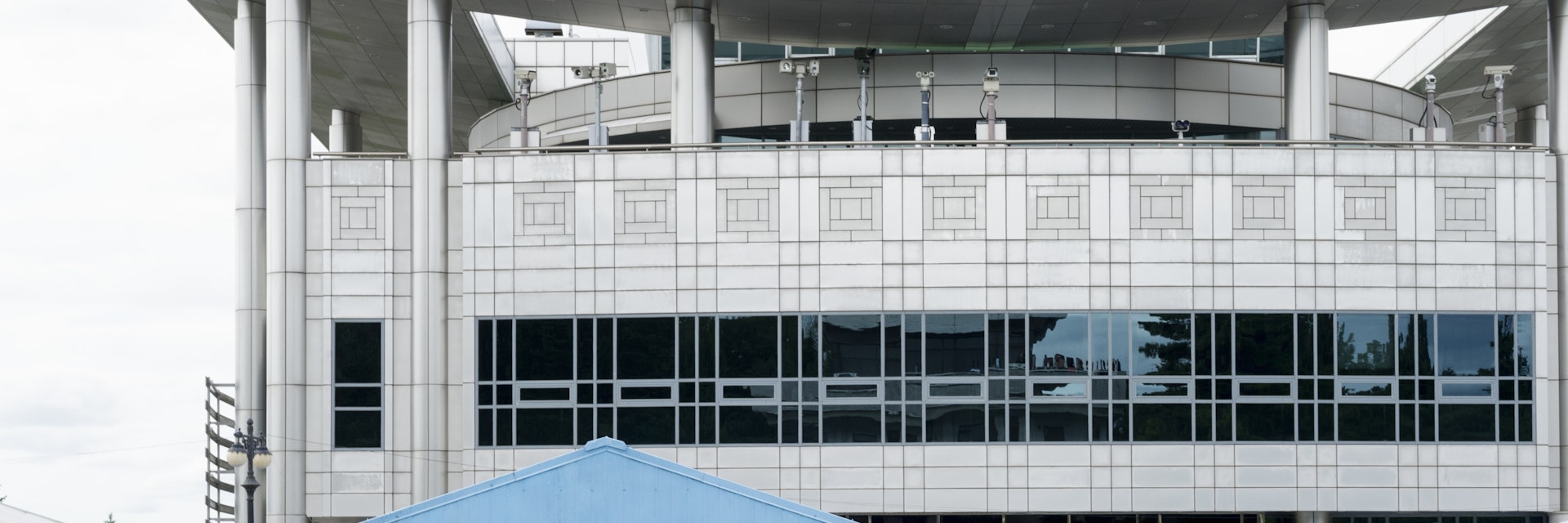The sad sight of a divided nation remains one of the most poignant aspects of any trip to North Korea. Even if you're just in North Korea for a couple of days, almost every tour includes a trip to the DMZ. Seeing the situation from the North – facing off against US and South Korean troops to the south – is a unique chance to witness things from an alternative perspective.
The eerily quiet drive from Pyongyang down the six-lane Reunification Hwy – the road is deserted save for military checkpoints – gives you a sense of what to expect. Just before you exit to the DMZ, the sign saying ‘Seoul 70km’ is a reminder of just how close and yet how far is normality.
There are several aspects to a DMZ visit. Your first stop will be at a KPA post just outside the DMZ. Here a soldier will show you a model of the entire site, pointing out South Korean as well as North Korean headquarters and watchtowers. Then you’ll be marched (single file!) through an anti-tank barrier to rejoin your bus, and you’ll be driven down a long concrete corridor. Look out for the tank traps either side – huge slabs of concrete ready to be dropped into the road at any minute in the event of a land invasion.
The next stop is the Armistice Talks Hall, about 1km into the DMZ. Here negotiations were held between the two sides from 1951 until the final armistice, which was signed here on 27 July 1953. You’ll see two copies of the agreement on display in glass cases, along with the original North Korean and UN flags. Next door there’s an exhibition of photos from the war. Outside, a plaque in red script best sums up the North Korean version of the ceasefire. It reads: 'It was here on July 27, 1953 that the American imperialists got down on their knees before the heroic Chosun people to sign the ceasefire for the war they had provoked June 25, 1950.'
From here you’ll reboard the bus and drive to the Demarcation Line itself, and you'll be reminded in more than usually severe language about sticking together ‘for your own safety’. The site consists of two sinister-looking headquarters staring at each other across the line (the North Korean one is built to be the bigger of the two) and several huts built over the line for meetings. Amazingly, you can cross a few metres into South Korea within the huts, but the doors out to the south are closed and guarded by two soldiers.
Being at the centre of the biggest military face-off on Earth is rather like being in the eye of a storm – tension is in the air, but it appears so peaceful that it makes the very idea of imminent combat seem ridiculous. South Korean and American soldiers eyeball their northern counterparts as they have done every day since 1953. Do not be fooled by the prevailing air of calm, though: any attempt to even approach the border will result in your being shot at, possibly from both sides. In the 1980s, however, a Soviet tourist found a unique way to flee the communist bloc, defecting amid gunfire from both sides. In recent years, North Korean soldiers have made the dash successfully in 2012, 2015, 2016 and 2017.
The other interesting sight at the DMZ is the Concrete Wall, a US-constructed anti-tank barrier that runs the length of the 248km border. It has been hijacked as an emotive propaganda weapon by the North, which since 1989 has been comparing it with the Berlin Wall. Indeed, the issue has proved an emotive one in the South as well, where students have demanded it be dismantled. You will inspect the wall with binoculars and be shown a particularly bizarre North Korean propaganda video.
